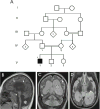Asparagine synthetase deficiency detected by whole exome sequencing causes congenital microcephaly, epileptic encephalopathy and psychomotor delay
- PMID: 25227173
- PMCID: PMC4915861
- DOI: 10.1007/s11011-014-9618-0
Asparagine synthetase deficiency detected by whole exome sequencing causes congenital microcephaly, epileptic encephalopathy and psychomotor delay
Abstract
Deficiency of Asparagine Synthetase (ASNSD, MIM 615574) is a very rare autosomal recessive disorder presenting with some brain abnormalities. Affected individuals have congenital microcephaly and progressive encephalopathy associated with severe intellectual disability and intractable seizures. The loss of function of the asparagine synthetase (ASNS, EC 6.3.5.4), particularly in the brain, is the major cause of this particular congenital microcephaly. In this study, we clinically evaluated an affected child from a consanguineous Emirati family presenting with congenital microcephaly and epileptic encephalopathy. In addition, whole-exome sequencing revealed a novel homozygous substitution mutation (c.1193A > C) in the ASNS gene. This mutation resulted in the substitution of highly conserved tyrosine residue by cysteine (p.Y398C). Molecular modeling analysis predicts hypomorphic and damaging effects of this mutation on the protein structure and altering its enzymatic activity. Therefore, we conclude that the loss of ASNS function is most likely the cause of this condition in the studied family. This report brings the number of reported families with this very rare disorder to five and the number of pathogenic mutations in the ASNS gene to four. This finding extends the ASNS pathogenic mutations spectrum and highlights the utility of whole-exome sequencing in elucidation the causes of rare recessive disorders that are heterogeneous and/or overlap with other conditions.
Conflict of interest statement
All authors have declared that no competing interests exist.
Figures


Similar articles
-
Deficiency of asparagine synthetase causes congenital microcephaly and a progressive form of encephalopathy.Neuron. 2013 Oct 16;80(2):429-41. doi: 10.1016/j.neuron.2013.08.013. Neuron. 2013. PMID: 24139043 Free PMC article.
-
A novel variant in ASNS gene responsible for syndromic intellectual disability and microcephaly: Case report and literature review.Mol Genet Genomic Med. 2024 Apr;12(4):e2424. doi: 10.1002/mgg3.2424. Mol Genet Genomic Med. 2024. PMID: 38546112 Free PMC article. Review.
-
Epileptic encephalopathy with microcephaly in a patient with asparagine synthetase deficiency: a video-EEG report.Epileptic Disord. 2019 Oct 1;21(5):466-470. doi: 10.1684/epd.2019.1100. Epileptic Disord. 2019. PMID: 31617495
-
Asparagine Synthetase deficiency-report of a novel mutation and review of literature.Metab Brain Dis. 2017 Dec;32(6):1889-1900. doi: 10.1007/s11011-017-0073-6. Epub 2017 Aug 3. Metab Brain Dis. 2017. PMID: 28776279 Review.
-
Congenital microcephaly with early onset epileptic encephalopathy caused by ASNS gene mutation: A case report.Medicine (Baltimore). 2020 May 29;99(22):e20507. doi: 10.1097/MD.0000000000020507. Medicine (Baltimore). 2020. PMID: 32481472
Cited by
-
Effects of A6E Mutation on Protein Expression and Supramolecular Assembly of Yeast Asparagine Synthetase.Biology (Basel). 2021 Apr 3;10(4):294. doi: 10.3390/biology10040294. Biology (Basel). 2021. PMID: 33916846 Free PMC article.
-
Monoallelic and biallelic mutations in RELN underlie a graded series of neurodevelopmental disorders.Brain. 2022 Sep 14;145(9):3274-3287. doi: 10.1093/brain/awac164. Brain. 2022. PMID: 35769015 Free PMC article.
-
Asparagine synthetase deficiency: A novel case with an unusual molecular mechanism.Mol Genet Metab Rep. 2019 Nov 1;21:100509. doi: 10.1016/j.ymgmr.2019.100509. eCollection 2019 Dec. Mol Genet Metab Rep. 2019. PMID: 31720226 Free PMC article.
-
Characterizing asparagine synthetase deficiency variants in lymphoblastoid cell lines.JIMD Rep. 2023 Jan 5;64(2):167-179. doi: 10.1002/jmd2.12356. eCollection 2023 Mar. JIMD Rep. 2023. PMID: 36873094 Free PMC article.
-
Increased glycine contributes to synaptic dysfunction and early mortality in Nprl2 seizure model.iScience. 2022 Apr 29;25(5):104334. doi: 10.1016/j.isci.2022.104334. eCollection 2022 May 20. iScience. 2022. PMID: 35602938 Free PMC article.
References
-
- Ai J, Tang Q, Wu Y, Xu Y, Feng T, Zhou R, Chen Y, Gao X, Zhu Q, Yue X, Pan Q, Xu S, Li J, Huang M, Daugherty-Holtrop J, He Y, Xu HE, Fan J, Ding J, Geng M. The role of polymeric immunoglobulin receptor in inflammation-induced tumor metastasis of human hepatocellular carcinoma. J Natl Cancer Inst. 2011;103:1696–1712. - PMC - PubMed
-
- Al-Gazali L, Ali BR. Mutations of a country: a mutation review of single gene disorders in the United Arab Emirates (UAE) Hum Mutat. 2010;31:505–520. - PubMed
Publication types
MeSH terms
Substances
Grants and funding
LinkOut - more resources
Full Text Sources
Other Literature Sources
Medical

